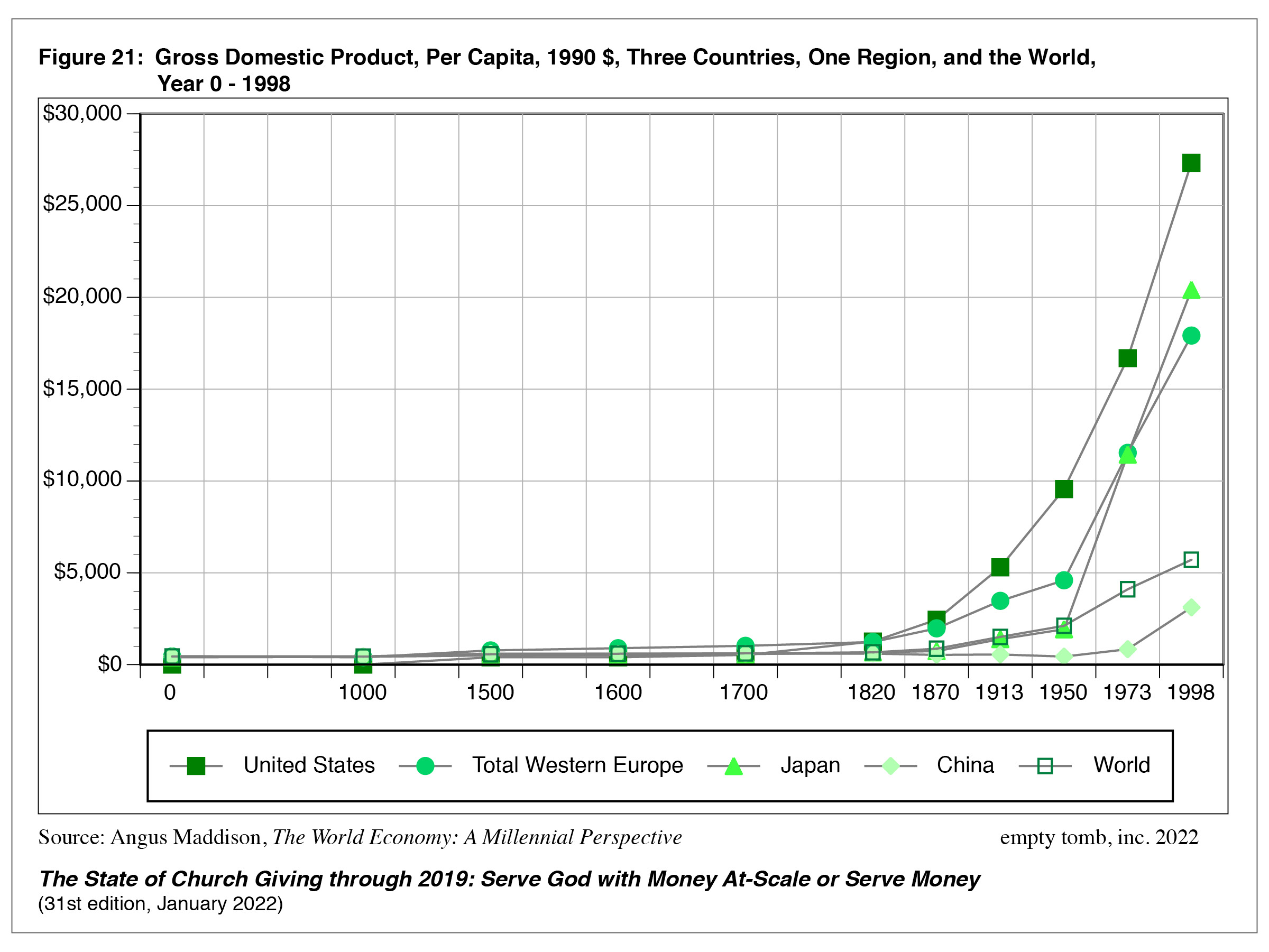Declining Church Giving Facts & Solution: empty tomb's Latest The State of Church Giving Edition
NEWS PROVIDED BY
empty tomb, inc.
Aug. 30, 2022
CHAMPAIGN, Ill., Aug. 30, 2022 /Christian Newswire/ -- Fact: Church member giving declined in 2019, the year before the COVID pandemic took off, according to data published in empty tomb’s latest edition, The State of Church Giving through 2019: Serve God with Money At-Scale or Serve Money (January 2022).
Fact: As giving to churches as a percent of income declined between 1968 and 2019, so did church membership as a percent of U.S. population.
Fact: Those in the U.S., including church members, are living in an age of affluence not seen during the previous 2,000 years, according to an analysis by economist Angus Maddison considered in the new book (see accompanying chart).

Click to enlarge
Solution: Churches need to recover their roots, putting mission before maintaining operations. In so doing, churches will be serving God rather than money.
Specific Giving and Membership Facts.
The first seven chapters of the book analyze different aspects of church giving and membership.
- For a composite set of Protestant denominations, in 2019, the year before COVID hit, per member giving in current dollars, as well as in inflation-adjusted dollars and as a portion of income, was lower than the year before in 2018 (chapter 1).
- In 2019, U.S. per capita after-tax, inflation-adjusted income had increased 171% compared to 1968. Yet, instead of increasing or even just maintaining the portion of income given to the church, per member giving as a percent of income decreased 35% from the 1968 base, from 3.02% to 1.95% (chapter 1).
- In 2019, of the money that came into a congregation, 84% was spent on the church's internal activities, and 16% was spent on the larger mission of the church. Those numbers indicate a turning inward, compared to 1968, when 79% was spent on the church's internal activities, and 21% was spent on the larger mission of the church (chapter 1).
- The declining trends are evident in both mainline and evangelical Protestant denominations (chapter 3).
- For a data set of 11 major Protestant denominations, giving as a percent of income was lower in 2019 than in 1921 or 1933, the depth of the Great Depression (chapter 4).
- A data set of 34 Protestant denominations, including some of the fastest growing in the U.S., and the Roman Catholic Church, represented 45% of the U.S. population in 1968 and 33% in 2019 (chapter 5).
What Is the Solution?
Chapter 8 explores a solution to these trends.
U.S. per capita Gross Domestic Product grew over 2000% from 1820 to 1998 in constant 1990 dollars, according to economist Angus Maddison's analysis. Since 1998, U.S. per capita GDP has continued to grow.
In the face of this unprecedented affluence, the church needs to dust off Jesus' advice from 2000 years ago and figure out what it means to serve God rather than Money (Matthew 6:24) in this new circumstance.
Relevant quotes from church leaders reflecting on Jesus' teachings, including Augustine of Hippo, Martin Luther, and John Wesley, are presented in the book.
The new book suggests this accumulated wisdom points to a solution. The new affluence has encouraged an increasing focus on the comfort of current church members. The solution is recovering an outward focus on a scale made possible by this great affluence.
By its nature, Christianity is aspirational. If the church is not aspiring to a goal that is on a scale with the resources available and the need in the world, the church will wither.
The church can help others in desperate need, and do it in Jesus' name, at a level never before possible. A side benefit of this recovered approach might be a revitalization of the church itself as people become interested in the churches' larger purpose.
What Is the Potential for Good?
Chapters 6 and 8 document the financial potential of church members to impact global needs.
To make a shift from an internal to external emphasis, the book suggests, the church needs to focus on where the needs are the greatest. Global needs present a challenge on a par with the affluence flooding the U.S.
A specific need considered in chapter 8 is the more than 1 million children under age 5 dying each year from preventable causes. Using the still available distribution and communication systems of denominational channels, churches could embrace a vision of reducing these needless deaths.
Church members currently conduct all their activities on less than 2% of their incomes. If they donated another 6%, and focused on their global neighbors' needs, these church members would have had an additional $454 billion in 2019 to apply to these needs.
Is that enough? The book cites a combined figure of $83.2 billion a year more that is needed for churches to address, in Jesus' name, child deaths; Bible translation and workers for unengaged, unreached people groups; nutrition security; water-sanitation-hygiene basic services; and basic primary education availability.
The solution to the downward trends, then, is dependent not on the church's ability to act, but rather, in light of these facts, whether the church chooses to use the power for good now at its command.
The new book, the 31st in the series, was published January 2022. It is available at Wipf and Stock Publishers, wipfandstock.com.
SOURCE empty tomb, inc.
CONTACT: Sylvia Ronsvalle, 217-356-9519, research@emptytomb.org

